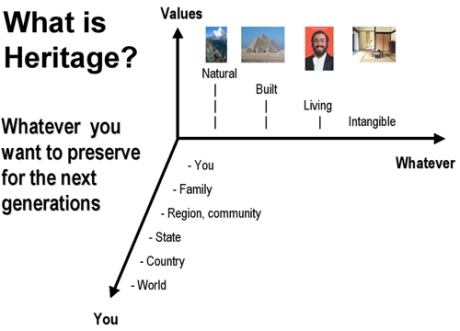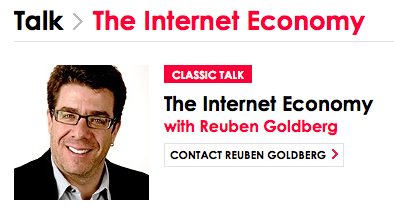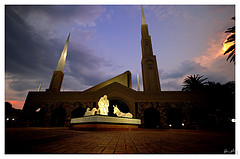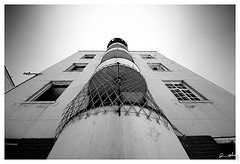A nation built on respect for cultural diversity February 10, 2009
Posted by Heather Ford in Announcements.add a comment
Janine Erasmus from Media Club South Africa has written a great article about the Open SA! project. Wonderful to see the great interest in this project from the local media!
Digitisation and access seminar footage now available! February 10, 2009
Posted by Heather Ford in Announcements.1 comment so far
Thanks to the great team at the African Commons Project, video, audio, pictures and a summarised report of the seminar held on the 4th of February are now available here. Remember that everything on this site is licensed under a Creative Commons Attribution license which enables anyone to republish the material on their own site/publication as long as they attribute iHeritage and provide a link back to this site.
Ephemera to Artefact – Digital Repositories Online February 10, 2009
Posted by Rebecca Kahn in Features.add a comment
In preparation for the seminar, I started out thinking about artefacts – what they are and how they are defined.
The best definition I found was from Wikipedia, and it defined artefacts as “An object made by a human being, typically something of cultural or historical interest”.
This definition is useful, because it can be used for many different kinds of artefacts, both those that exist in the analogue world, which most people are familiar with, and the digital world.
Analogue artefacts are easy to identify. They’re the sculptures, paintings, songs, and artworks that we all know from the museums, archives and repositories that we are familiar with.
But in the digital world, the term “artefact” is an accurate descriptor for many more works that are less easy to categorise. For example, videos, online maps, photos from Flickr, blog posts and eBooks are all artefacts, if we return to our original definitions.
But we can’t always find these artefacts in the spaces we are used to looking in. Many of them aren’t in museums, libraries or archives. They’re being created in the digital world, and being stored in digital spaces. This may be sufficient for now, but the reality is that these digital spaces like Flickr, YouTube and Google aren’t libraries or museums, and were never designed to be. They’re commercial entities, built to be businesses, and owned, often, by clever people, who aren’t, and never intended to be, archivists. It’s an ill-fit. And this ill-fit is often compounded by the fact that people use these spaces as if they were archives, libraries or museums, because it’s often easier to look for information on Google than it is to go to a library.
However, there are some online spaces that really are archives in any sense, and some people who are approaching the Internet and all the content in it from a traditional archival perspective.
The first is the Internet Archive. This is an organisation that started with the specific aim of taking Internet content and reclassifying what many people consider to be ephemera as artefact by creating an online archive of the Internet.
The Internet Archive has several components. The first is called the WayBack Machine. This is less of a machine and more of a real-time archive of the Internet. It takes “snapshots” of the Internet at regular intervals, and is able, that way to provide an ongoing time capsule of what is online at any one time.
All the material on the Internet Archive, in the Wayback Machine or in the other collections, is free to use for researchers, scholars and historians, and it is all available for reuse, either under Creative Commons licences, or in the Public Domain. The Internet Archive also has extensive digital media, text, moving image and audio archives, including archived material from the BBC, Wikipedia, Apple, Amazon, Microsoft, Google and the Open Dictionary.
Another feature of the Internet Archive this the Archive IT project. This project is an immediate, permanent archive, based on a subscription model, for any digital collection. As of February 2009 there are 700 million unique URLs and 718 public collections hosted on Archive IT. What makes this project particularly interesting from an archival perspective are the collections that have chosen to host their digital collections on the site. The national libraries of Australia and Chile have uploaded their collections, as well as libraries from academic institutions like Stanford and Columbia universities in the USA, The University of Toronto and the University of Ghent. Archival institutions have also chosen to use it, and collections from the British Slave Legacy Project and the Electronic Literature Organisation are hosted on the site.
Another good example of an online repository is Project Gutenberg, which is one of the oldest digital repositories on the Internet. Founded in 1971, it is a free of charge, free to use, free to reuse library of eBooks. It’s funded by volunteers and a charitable foundation, and relies heavily on volunteers to help with the effort to digitise, archive and distribute cultural works and to encourage creation of ebooks, audio books, and digitised sheet music.
At the time of writing there are full texts of over 27 000 public domain books in open formats, and in several languages in Project Gutenberg, ranging from ancient texts from Shakespeare and the great Hindu epic the Mahabharata to the poetry of C Louis Liepoldt.
There are several pros associated with the use of online repositories like The Internet Archive and Project Gutenberg for South African heritage projects:
• Tech is taken care of – digitising a collection is an expensive undertaking, and often, it’s the cost of building the software that makes it really daunting. In case of these repositories, the software is there. And it’s been built and is being maintained by geeks who are into archives, which means the cost and responsibility isn’t the archives problem. This makes them perfect for collection of all sizes.
• Scalable – It is easy for the material to go from one source to many, many users, because it’s easily accessible and free. • Copyright “free” – only material around which there are no copyright issues is uploaded.
• Assured of the longevity of the projects – these archives aren’t going anywhere. They’re not a business that might go bust. This is what they are mandated to do. They’re making allowances for new technology and media as they are created.
However there are also several drawbacks:
• There is very little South African content on either of these sites.
• Ownership is often a contentious issue in the heritage sector in South Africa, and many people who may donate material are suspicious of a foreign entity that appears to be taking their heritage.
• No versions of these repositories exist in South African languages other than English.
• Awareness of the public domain on the Internet is very low in South Africa, and very few people know about this provision, let alone understand how to use it.
By profiling these case studies, I’m in no way suggesting that we reinvent the wheel, and I’m not suggesting that all archives abandon current projects and add all their material to Internet Archive, or to Project Gutenberg. But I think, if we started to think about these archives, and the other out there like them, in a more integrated way, there could be very exciting possibilities.
Imagine a public library in Queenstown that has a portal to Project Gutenberg, so all library users can access the Gutenberg holdings. Or a classroom that uses the Internet Archive for school projects, allowing kids to download and use the resources supplied, and upload their own content into the archive where it will be preserved forever.
One of the most exciting features of the internet is that it is inherently global and democratic, and I think that if South Africans start participating a little bit more in this global democracy, there could be results that we can’t even begin to imagine.
From ‘view’ to ‘embed’ to ‘remix’ and ‘republish’: The future of heritage February 10, 2009
Posted by Heather Ford in Features.2 comments
At last week’s seminar, I presented the major trends that I feel the heritage sector is moving towards in a presentation entitled: ‘From ‘view’ to ‘embed’ to ‘remix’ and ‘republish’: The future of heritage’.
I started by explaining what ‘heritage’ actually is and why it is important by quoting from François LeBlanc’s essay entitled: ‘Is everything heritage?‘
I then went on to discuss the history of heritage preservation. Starting by looking at ancient oral storytelling practices where there are no legal restrictions on who is allowed to pass on knowledge, I then addressed the first museums – ‘cabinets of curiosities‘ that were built by the elite classes in Renaissance Europe. I said that, although museums had become much more democratised in the twenty-first century, they are still largely inaccessible a) due to physical limitations of the world’s most important museums only being available to people in major cities, and b) due to legacy copyright restrictions in place that prevent the original ‘passing on’ of knowledge that we benefited from in ancient times.
The result of these limitations is that many museums are out of touch with modern day society. What was built by modern society to preserve our heritage for future generations has, effectively, become another tool for ‘telling’ us a particular view of history (or ‘showing us’ their particular selection of ‘curiosities), rather than enabling us to ‘pass on’ what we feel is important.
I then talked about the problems of the ever-widening scope of copyright as a primary source of the inability of museums to become platforms for sharing or ‘passing on’ heritage from one individual to the next. As copyright has widened in scope and term over the past century, its restrictions have come to cover even our heritage and memories. With copyright limitations being default, and not requiring registration, museums are saddled with the problem of finding copyright owners of donated materials in order to get their permission for publication and sharing of the materials outside of the walls of the museum.
In response to the problems of over-zealous copyright protection, a number of tools have been developed to assist organisations in fulfilling their primary function by making materials accessible to a wider audience using the democratising power of the Internet. Creative Commons, for example, has developed a set of copyright licenses that allow the copyright-holder to mark the freedoms associated with a work by default. A license like this enables museums to develop model agreements with those who donate to the archive which then allow (commercial or non-commercial) sharing of the works (or images of the works) online.
Other museums have made use of public domain provisions by keeping records of materials that have fallen out of copyright and can then be made accessible to a wider audience who are free to pass on the information to others. Fair dealing provisions have also been used by some museums to make certain works available for educational, non-commercial use.
In all these examples, I tried to make it clear that the most important function of museums in going online is that they preserve the ‘passing on’ function of early storytelling by clearing rights as far as possible to enable a new generation of online creators to be able to republish the materials and therefore pass them on to a whole set of new audiences.
>> Video of the presentation is available on the Internet Archive.
Hidden Gem January 29, 2009
Posted by Rebecca Kahn in Features.Tags: heritage, Hidden Gem, Internet Archive, openSA!, video
1 comment so far
All over the internet, hidden away in archives, lurking on video-sharing sites, swimming in photo-streams and waiting quietly in the wings are (literally) thousands of of images, shorts, films, posts, photos and audio clips that reflect the fantastic heritage of South Africa and South Africans.
In what we’re hoping will be a regular feature on this site, we’re going to showcase the random gems that we stumble upon in our continual search for SA heritage and cultural artifacts online. This week, we’ve found a short documentary made by Link Media Inc, which looks at the Golden Dragon Restaurant, one of the very first Chinese restaurants in Cape Town. It’s a fascinating look at people who once considered themselves to be strangers in a strange land and yet who were a cornerstone in their community. It also examines how the Chinese community is only now shaking off its confusion to claim its place in the new South Africa.
This documentary is part of the Open Source Movies collection on the Internet Archive, and is licensed under a Creative Commons Attribution Non-Commercial license which means that you can remix and/or republish this as long as it is for non-commercial purposes.
We have a new logo! January 27, 2009
Posted by Heather Ford in Announcements.Tags: paraffin
add a comment
 Thanks to Paraffin Design who kindly donated a redesign of the OpenSA! logo for us! We love it – especially because it has forced us out of our obsession with the colour green. If you’re interested in using the button on your website, you can download it from Flickr here.
Thanks to Paraffin Design who kindly donated a redesign of the OpenSA! logo for us! We love it – especially because it has forced us out of our obsession with the colour green. If you’re interested in using the button on your website, you can download it from Flickr here.
Welcome Classic FM listeners! January 23, 2009
Posted by Heather Ford in Announcements.Tags: classic FM
add a comment
If you’re here because you listened to Reuben Goldberg’s Internet Economy show today, welcome! We’re looking for people with video footage, photographs, audio or text about South Africa who are willing to share it in a pilot campaign to make South African heritage more accessible online.
Read more about what we need and what we’re about here. And be sure to subscribe to the blog feed for the latest updates on who is joining the campaign. If you don’t know what a blog feed is, read the Wikipedia entry here or find out more by going to the Google Reader service.
Gregor Rohrig shares with OpenSA! January 22, 2009
Posted by Daniela Faris in Features.Tags: Gregor Rohrig, photography
1 comment so far

Gregor Rohrig shares his passion for photography with the world
New Media specialist and photographer, Gregor Rohrig, is the first person to contribute cultural and historical materials to the OpenSA! project. He has contributed these beautiful photographs of scenes and cityscapes of Johannesburg. We spoke to Gregor about why he donated his images to OpenSA!, and about why his contribution and the contributions of others will allow creators, historians and thinkers to dig into a rich public domain filled with South African cultural and historical artifacts.
OpenSA!: Tell us a bit about what you do…
Gregor: I work as the New Media Specialist at Avusa Media‘s innovation unit (iLab) and am part of a team that is researching, project managing, and implementing new online and mobile applications. I am also an avid photographer, which is my further passion. I’ve been taking photographs for the last nine years, having worked as a professional, commercial, and freelance photojournalist, and to date still love every second I spend peering through a viewfinder.
OpenSA!: How did you first become interested in the issues around open licensing, sharing economies and remix culture?
Gregor: I became interested in the issues around open licensing while studying and working for a student newspaper. I had the idea of allowing the content that was produced by students for the paper to be shared and remixed by other student publications. Since there was no commercial gain for writing for these publications it made sense for students to collaborate and exchange news and information on what was happening on their campuses. So we licensed our student publication under a Creative Commons license and successfully endeavored to persuade other publications to do the same.
It was gratifying to change conventional perceptions through successfully advocating the ideas surrounding open licensing and ever since, I have been interested, and have attempted, to be part of this emerging remix culture.
OpenSA!: These issues, particularly for creators of content, aren’t just ideological – they’re also very emotional. Do you think South African creators are embracing the ideas more? Or are their responses still quite emotive?
Gregor: Without understanding the benefits of sharing and remixing it makes sense that many creators of content respond emotionally and reluctantly towards these ideas.
I think many creators are emotive about the idea of allowing their content to be “freed”. They probably feel like they losing all control of their work, but are not aware of what the benefits of sharing their work for themselves and for others.
OpenSA!: Do you think the idea of a public domain of material for artists, filmmakers and other ‘creatives’ is a viable idea in South Africa? Or do you think we’re still too focused on “ownership”?
Gregor: With the incalculable amount of historic and cultural material South Africa harbors, it is not just only a viable idea, but is in the best interests of South Africa and South Africans to participate in establishing a public domain of material. What good are the historic and cultural materials if they cannot be used and reused creatively?
I do believe that there is still a very strong focus on “ownership”, especially when it comes to local cultural and historic material that is “owned” by museums.
OpenSA!: What do you think the implications of a freely accessible public domain could be for the creative industry in South Africa?
Gregor: We would be able to explore and represent issues like never before. As mentioned above, with the vast amount of historic and cultural material available, the creative industry could become inspired to produce unique, local material that can inform, entertain, and educate.
Imagine making use of local material that has never been accessible before. Imagine how inspired and encouraged the creative industry would be to create fresh imaginative content. Imagine a positive mind-set of sharing spreading throughout a nation. The idea of “freeing” content goes beyond the materialistic, and has the potential to change the general attitude of selfish notions.
OpenSA!: Have you ever seen any examples of your work being reused and remixed?
Gregor: Yes, several of my photographs have been reused in print and online publications. I have however not seen any of my images remixed yet, but would love to see how they could be reinterpreted and reworked!
OpenSA!: What one piece of footage/image/audio would you love to see made freely available for all people to reuse?
Gregor: Images, video footage and audio of our beloved Tata Nelson Rolihlahla Mandela!
What is the Public Domain? And Why Should We Care About It? January 21, 2009
Posted by Rebecca Kahn in Features.Tags: openSA! copyright heritage, public domain
2 comments
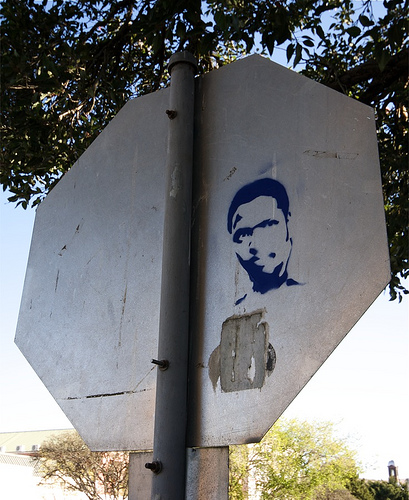
Discussions around heritage and heritage material often revolve around the idea of the Public Domain, and what material should or shouldn’t be released into it. But what exactly is the Public Domain, and why does it matter?
“Public Domain” refers to those works that the public has an unlimited right to copy, adapt and share. The Public Domain includes works that are not in copyright, either because they have never been under copyright, or because the term of copyright under which they had been protected has expired. The Public Domain also includes creative and intellectual elements, such as the plots of a book or film, which cannot be subject of copyright, or other intellectual property. The Public Domain is essentially, public property and is free for anyone to adapt, build upon, copy, distribute and perform.
Many important historical works are part of the Public Domain. The Mahabharata and the Ramayana, the two major Sanskrit epics of ancient India are Public Domain works, as are the compositions of Mozart, the plays of Shakespeare, the Mali Manuscripts from the 13th century and the novels of Dostoevsky. The Public Domain is important because it is an accessible, usable collection of the historical, scientific, technological and cultural works of a society. Having access to works like these fosters learning, innovation and the development of new works and encourages creativity. Having access to a rich collection of Public Domain works means that teachers can make materials available for students, publishers can publish low-cost volumes, libraries can develop digital repositories and researchers can access and use each other’s information without having to worry about the cost and logistical issues involved in finding rights holders and getting their permissions to adapt or use the works.
The Public Domain, however, is under threat. The constant extension of copyright terms for longer periods means that less work is entering into the Public Domain globally, and access to important cultural, scientific and creative knowledge is restricted. The creation of new categories of rights also reduces the Public Domain.
One way of building the Public Domain is to encourage artists, musicians and other creators to release some of their work without any copyright, and explicitly state this on the work. Another way to help foster the growth and health of a Public Domain is for people to donate material. The Internet Archive, an online archive of material on the internet, is a good example of a donation-based Public Domain repository. Another example of an online Public Domain repository is the Open Library project, a sub-project of the Internet Archive, and an attempt to build an online repository of digitised, Public Domain books. At the time of writing, the Open Library project features the full text of over a million books online, for anybody to access, read and reuse. Project Gutenberg, a project to provide free e-books is similar, and has a huge collection of Public Domain books.
Image: Steve Biko by caribbeanfreephoto on Flickr, CC BY-NC-ND 2.0
Open SA! January 13, 2009
Posted by Heather Ford in Announcements.Tags: openjozi, openSA!
add a comment
Open SA! is a pilot project in collaboration with SA Rocks and the African Commons Project to enable people with great historical and cultural materials about South Africa to share them online for the benefit of all. We believe that getting ordinary people involved in sharing their history on the internet with artists, historians, students and researchers is a great way to keep local history alive and accessible. Read more about the project and how you can help!
